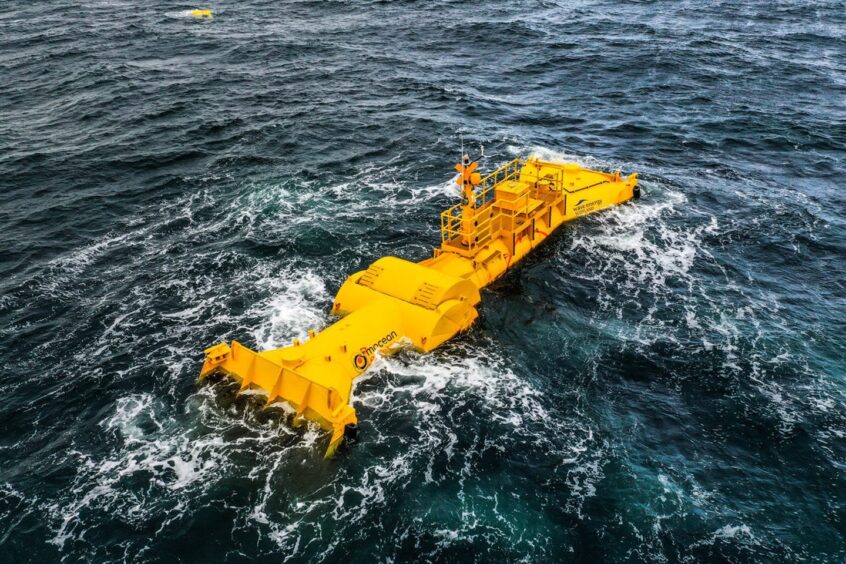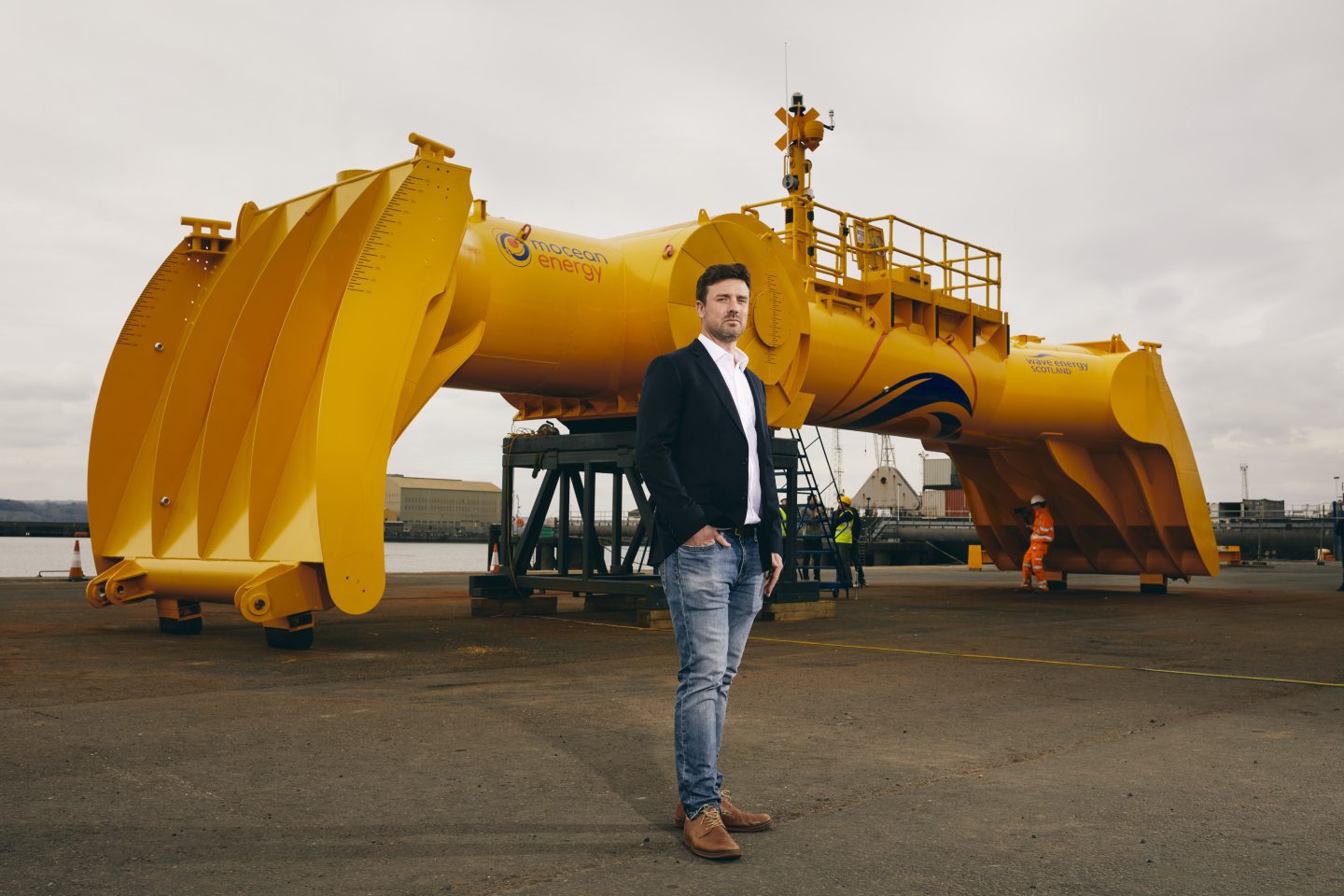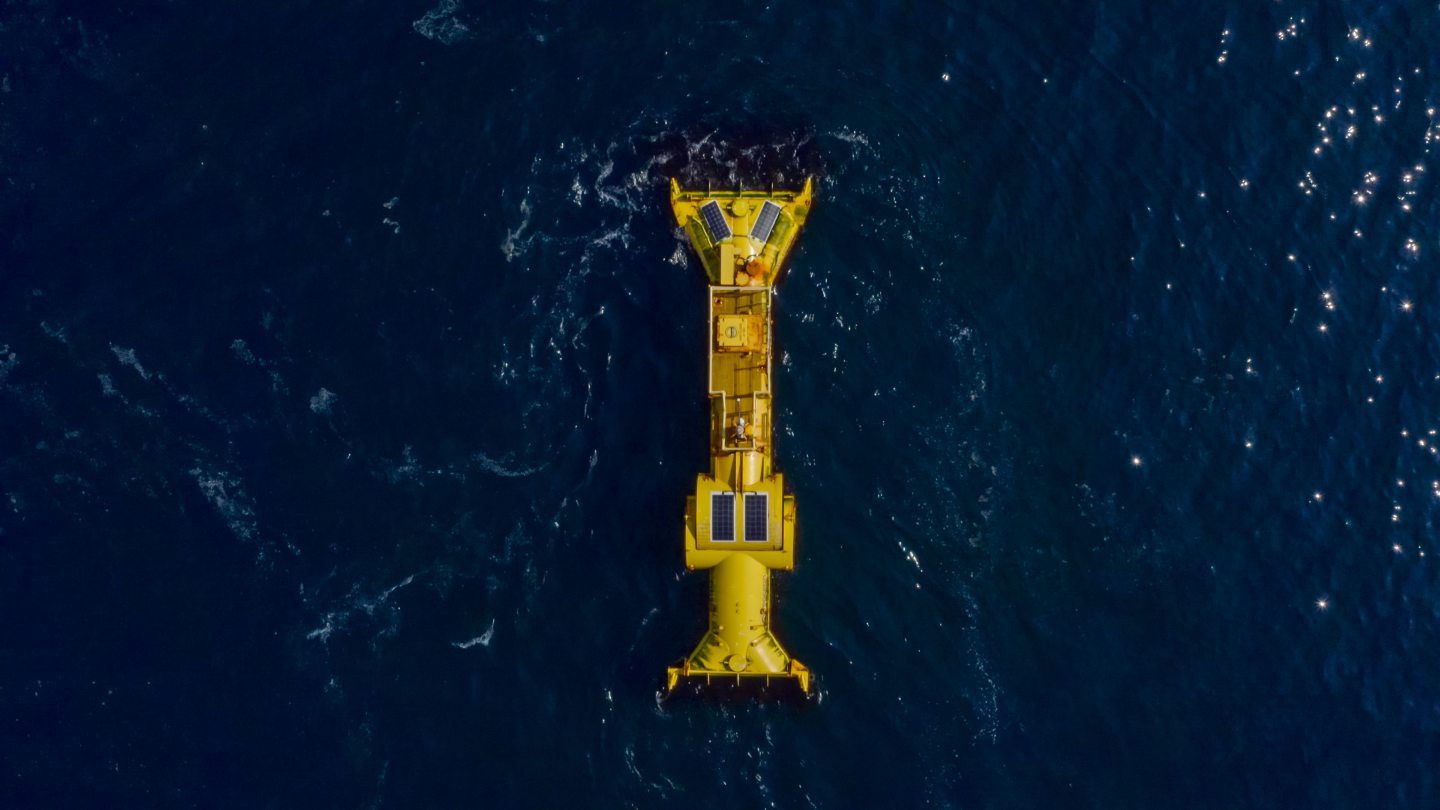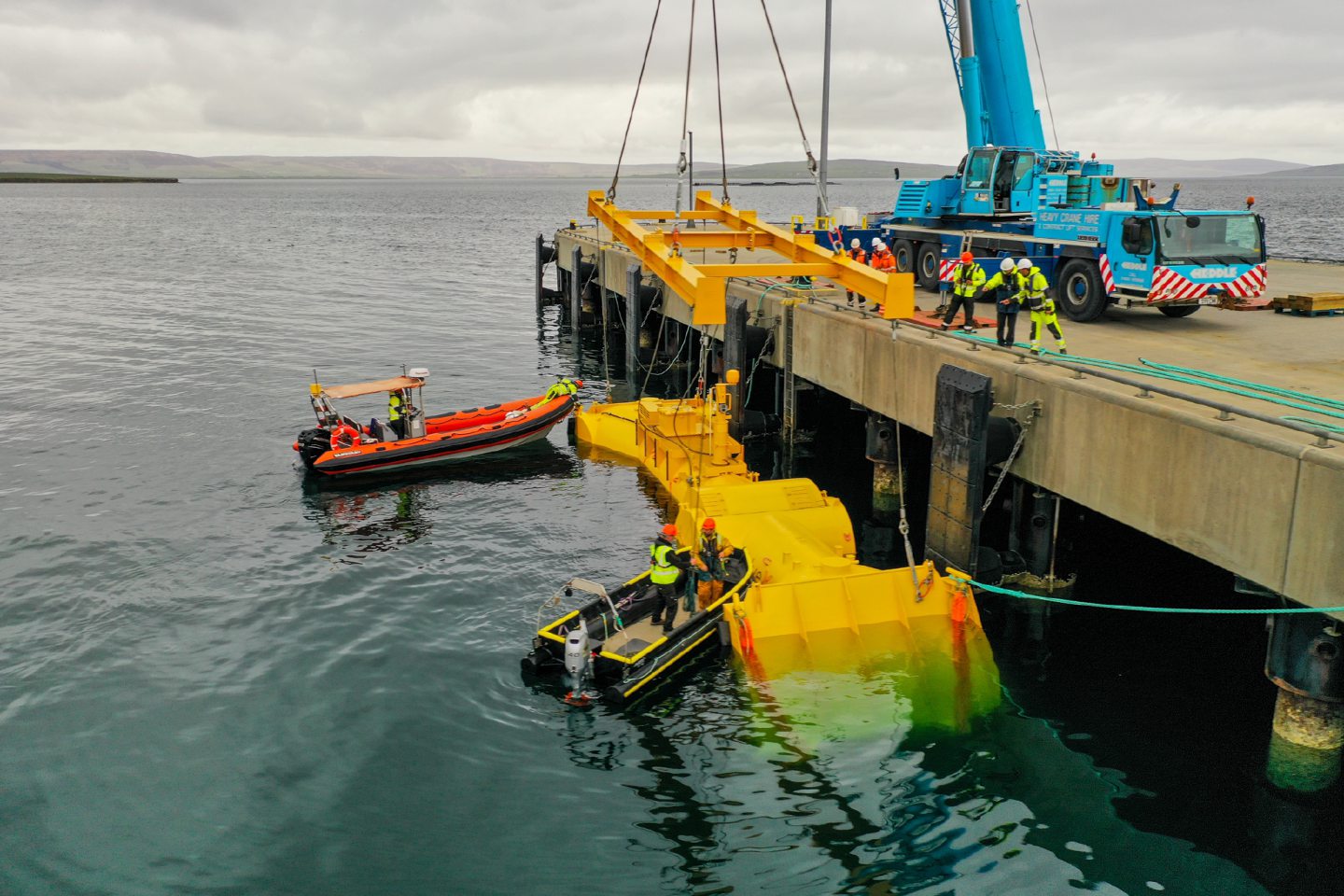
Scottish wave energy developer Mocean Energy is targeting international expansion in Australia and the US as it looks to secure its first commercial orders in 2025.
Founded in 2015, Edinburgh-headquartered Mocean first launched its prototype Blue X wave energy converter (WEC) for testing off the coast of Orkney in 2021.
The Blue X later played a key role in the renewables for subsea power (RSP) project, focused on decarbonising power supplies for subsea oil and gas operations. The project involved a subsea battery designed by Aberdeen’s Verlume and North Sea operators including Shell and TotalEnergies.
Since the Blue X returned to shore, Mocean has focused on commercialising its prototype with the launch of the Blue Star model.
Alongside the Blue Star, Mocean is also developing a larger, second-generation WEC known as Blue Horizon, which it hopes to deploy at utility-scale globally.
Speaking to Energy Voice, Mocean Energy co-founder and managing director Cameron McNatt said the company is close to securing its first commercial WEC orders in 2025.
But at the same time, Mocean also has its eyes on further international expansion within offshore oil and gas, as well as other sectors of the so-called ‘blue economy’.
The company recently secured a partnership with German subsea engineering firm SubCtech, and McNatt sees significant opportunities for the firm Down Under.
Mocean Energy’s Australia push
In fact, McNatt said Australia is potentially Mocean’s “biggest focus altogether” due to its significant wave resources and the nature of its offshore oil and gas sector.
“Particularly the west coast and the south coast of Australia have one of the biggest wave resources in the world,” he said.
“I think the interest in Australia is so big because there’s a lot of subsea development down there – a lot of the offshore oil and gas [projects] they do are subsea developments.
“They tend to have these long tie-backs [and] very remote locations where they’ve got subsea Christmas trees, and they need to get power to them. And that’s our whole value proposition.”
Getting the relatively small amounts of power required for subsea infrastructure in remote areas is “expensive and carbon intensive” McNatt said, and cable failures are “relatively frequent” due to the local marine conditions.
As a result, Australian operators are taking note of Mocean’s solution, which incorporates wave energy alongside solar, energy storage and a communications link.
As well as decarbonising existing infrastructure, McNatt also sees opportunities as Australian operators invest in new gas and carbon capture and storage (CCS) projects.
“It’s really a market pull as much as anything else,” he said, noting particular interest in Western Australia where much of Australia’s oil and gas is centred.
North Sea contrast and US opportunities
Compared to the North Sea, McNatt said Australia’s oil and gas firms are “more bullish” and willing to invest in decarbonisation, particularly as the country’s Labour government looks to boost natural gas production.
McNatt said he sees plenty of “enthusiasm” and a “different mood” in Australia.
“The offshore oil and gas sector in the UK is facing some challenges, let’s say, but it’s not the case [in Australia],” he said.
“Certainly there’s a regulatory environment in Australia, and there are new requirements for decarbonisation of operations and balancing out production with carbon capture.
“But there’s still a lot of new projects happening.”
Alongside Australia, McNatt said Mocean is also looking at commercial opportunities in the US. The company is also eyeing up “imminent projects” within the oil and gas sector in Norway and Thailand.
Mocean’s Blue Horizon
As Mocean looks to continue developing its Blue Star and Blue Horizon models, the company is also preparing for a series A financing round later this year.
Since 2020, Mocean has raised more than £7.8 million from a mix of equity investments and Wave Energy Scotland, Innovate UK and EU grant funding.
Mocean equity investors include Scottish Enterprise, Equity Gap, the University of Edinburgh, Katapult Ocean and Japanese shipping conglomerate MOL.
McNatt said Mocean already identified some “promising lead investors”, which he hopes “will take the business to the next level”.
Alongside the funding round, Mocean is aiming to achieve another milestone in 2025 as it targets its first commercial hardware sales by the end of the year.
A longstanding agreement with Dundee fabricators TEXO means the first Blue Star orders will roll off the production line in Scotland, with the aim of delivering projects in 2026.
America a land of opportunity for Mocean
But Mocean is also looking to take advantage of a “substantial” $112.5m (£90m) wave energy funding offer from the US Department of Energy (DOE).
If successful with its application, it would see Mocean establish, build and test a first-of-a-kind demonstrator of its Blue Horizon model in the US.
McNatt said the DOE funding call presents a big opportunity for Mocean, and he urged the UK government to follow Scotland’s lead in supporting wave and tidal firms.
“Scotland’s been very supportive, absolutely instrumental in getting us to the point where we are,” McNatt said.
“But I do think there has been, proportionately, relatively little funding for wave and tidal energy at the UK level.
“Especially compared to the different Horizon Europe programmes that are in the tens of millions for both wave and tidal energy, and then this US DOE funding is a $112m bucket, which is massive for a single funding call.”
Wave energy competition
The DOE funding call is a sign of increasing competition for wave energy projects globally, and McNatt does not expect that to change with the arrival of Donald Trump’s second presidential administration.
“This project, assuming it all goes forward, is a five-year project, so it’ll outlive Trump’s administration,” he said.
“I think a lot of things [in the energy sector] have momentum that span beyond single terms of a president.”
McNatt said the need for wave and tidal energy will “continue to grow” globally, but he called for more innovation funding so that firms like Mocean can “scale up” in the UK.
At a recent Westminster Committee hearing, UK energy secretary Ed Miliband was pressed on what the government is doing to ensure the UK is not “outmanoeuvred by the Scandinavians and the Portuguese” on wave energy.
Swedish firm CorPower Ocean is developing the 5MW Saoirse wave array project off the west coast of Ireland with Simply Blue Group and ESB.
Despite developing and testing its technology in Scotland at EMEC, CorPower deployed its first pilot in Portugal due to difficulties obtaining EU funding following Brexit.
Meanwhile, Swedish-Israeli firm Eco Wave Power is also set to deploy its first MW scale project in Porto.
With international competition increasing, the UK wave and tidal sector is calling for the Labour government to commit £250m (approximately 3%) of the budget for publicly owned GB Energy to marine energy projects.
Scotland and wave energy
Embedding the marine energy supply chain in the UK will have particular benefits for Scotland, according to McNatt.
He said that, while the many planned offshore wind projects will provide benefits to Scotland’s economy, much of the manufacturing is done elsewhere.
“Sure, there’s a lot of money behind [offshore wind], and the electrons will end up onshore, but [with] wave energy and tidal energy it’s the project and the technology coming from Scotland,” he said.
“You’re getting the manufacturing here, of the actual energy generators.
“And then that technology, if we can develop it here and deliver high-percentage Scottish content projects, we can also export that and export not just machines, but also IP – so Scottish knowhow and businesses that can internationalise and grow globally.”
Mocean has already secured backing from Scottish Enterprise, and McNatt said the company is open to further investment from bodies such as the Scottish National Investment Bank.
And while wave and tidal energy developers cannot yet compete with the more mature offshore wind and solar industries on grid-scale projects, McNatt sees plenty of opportunities in the growing “blue economy”.
He lists offshore aquaculture, power-from-shore for ports, remote island decarbonisation, direct ocean carbon capture and deep-sea research as potential opportunities.
Mocean is already in early-stage discussions with firms such as Captura (which counts Equinor as an investor), SeaO2 and DEEP on potential collaboration, McNatt said.
“I think there are some exciting opportunities and it makes sense to work together early to co-develop solutions,” he said.
But he added that Mocean is being “pragmatic” in its approach and focusing its attention on near-term opportunities in the oil and gas market.
Recommended for you


 © Supplied by Mocean Energy
© Supplied by Mocean Energy © Supplied by Mocean Energy
© Supplied by Mocean Energy © Supplied by Mocean Energy
© Supplied by Mocean Energy